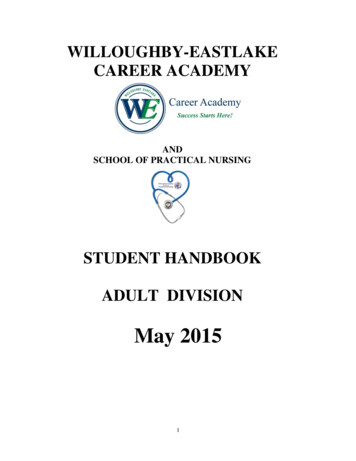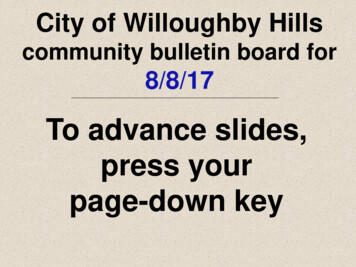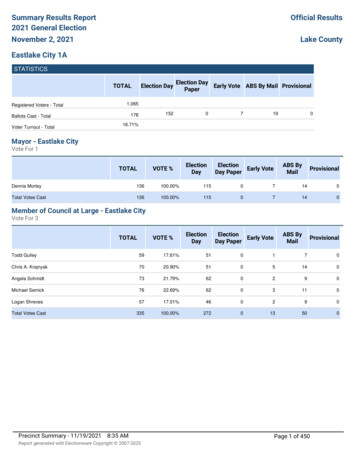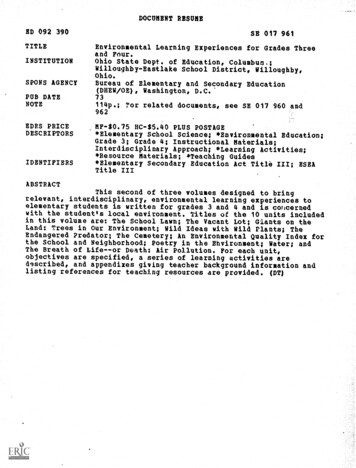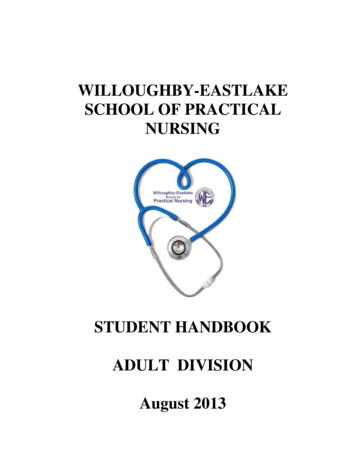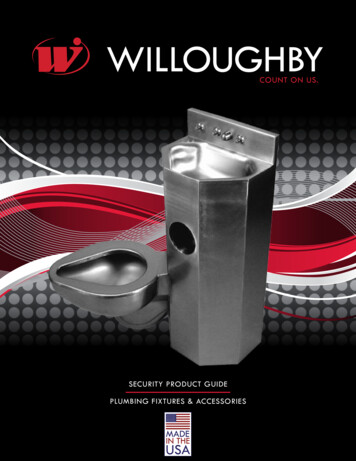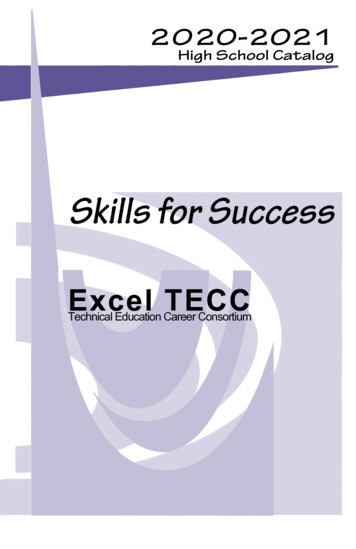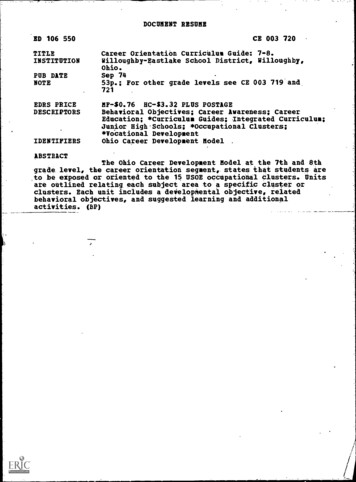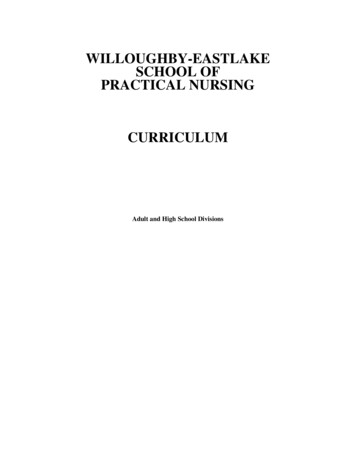
Transcription
WILLOUGHBY-EASTLAKESCHOOL OFPRACTICAL NURSINGCURRICULUMAdult and High School Divisions
WILLOUGHBY-EASTLAKE SCHOOL OF PRACTICAL NURSINGTABLE OF CONTENTSPhilosophy 3Nursing Objectives .4Conceptual Framework 5Body Structure .7Nursing Fundamentals .17Personal Vocational Relations .31Math .34Nutrition .37Introduction to Pharmacology .41Growth and Development .43Intravenous Therapy .51Medical-Surgical Nursing .54Pharmacology 83Obstetrical Nursing 89Curriculum 07/08; Revised 08/2012; Revised 08/132
WILLOUGHBY-EASTLAKE SCOOOL OF PRACTICAL NURSINGPHILOSOPHYThe faculty believes that nursing education is a deliberate process of learning by the student interestedin providing nursing care to others. In order to facilitate this learning process, we build ourcurriculum on these concepts:WE BELIEVE the person is a holistic being who is an individual, a member of a family, a member of a local,regional, and world community. Each person possesses individual, physical, emotional, social,economic, and spiritual self-care requisites. These self-care requisites can be met by either self-careagency, dependent-care agency, or nursing-care agency.health exists when the person has the ability to meet self-care requisites that contribute to themaintenance and promotion of structural and/or emotional integrity, functioning, and development.Illness occurs when an individual is incapable of maintaining self-care as a result of healthrelated limitations.society/environment includes all internal and external factors which effect the person's ability toadjust or maintain self-care agency or meet self-care needs.nursing is a service of deliberately selected and performed actions to assist individuals to maintain self-care,including structural integrity, functioning, and development. These actions should be based on the organizedapproach of nursing process which includes the following: assessment of the individual/patient in terms of self-care, developmental and health deviationrequisites identifying problems specific to the individual/patient and their unmet health care requisites using a cooperative effort with the individual/patient to establish goals establish a plan of care using appropriate members of the health care team and theindividual/patient implement the plan evaluate and revise the plan of care as necessarynursing education is the process by which the nursing instructor facilitates the student's psychomotor,cognitive, and affective skills to attain an entry level of nursing knowledge and competency. Entrylevel practical nursing skills are learned through the use of various competency builders.Program Curriculum - The core of knowledge obtained in this curriculum is viewed as a basis forbeginning practice in the nursing field. It is stressed to the student that as a member of a verydynamic profession, accountability for current knowledge is ever present. A continuous process oflearning is emphasized because of constant changes within the study of the science of nursing.Curriculum 07/08; Revised 08/2012; Revised 08/133
WILLOUGBY-EASTIAKE SCHOOL OF PRACTICALNURSING OBJECTIVESThe Willoughby-Eastlake School of Practical Nursing graduate, under the supervision ofthe registered nurse, licensed physician, licensed dentist or podiatrist, will be prepared to:1.Deliver nursing care through application of health concepts derived from thebiological, physical, psychosocial, and nursing sciences to assist client toattain optimal level of self-care agency.2.Implements the nursing process from a holistic point of view to attain,maintain, or regain optimal level of self-care agency.3.Contribute to the development and evaluation of health care plans utilizing thenursing process.4.Apply knowledge, judgment, and skill to safely and accurately administermedications.5.Safely perform nursing skills within established legal and ethical perimeters.6.Use various teaching methods in collaboration with the client, family, andhealth care team to provide information and instruction to exercise andenhance self-care agency.7.Employ verbal and written communication to convey pertinentinformation about the client's self-care requisites to the health care team.Curriculum 07/08; Revised 08/2012; Revised 08/134
WILLOUGHBY-EASTLAKE SCHOOL OF PRACTICAL NURSINGCONCEPTUAL FRAMEWORKThe conceptual framework consists of three areas of focus based on Orem's Self-Care Theory. Theseareas will progressively provide knowledge beginning with the overall needs of all persons at variousstages of development followed by the needs of those persons with health deviations.Included throughout the course will be the concepts of nursing process, health concepts,communications, ethics, nursing skills, and safety.Universal Self-Care Requisites: Introduces the beginning student to the basic function and needs ofthe individual. During this phase of the course, the student will acquire the foundation skills topermit them to deliver appropriate care.Developmental Self-Care Requisites: Focus upon human developmental processes and conditionsand events that occur during various stages of the life cycle, as well as with events that may adverselyaffect development. This phase of the course will enable the student to identify developmentaldeficits of a person and incorporate the skills and knowledge learned in the previous phase in order toprovide nursing care agency.Health Deviation Self-Care Deficit: During this final phase of the curriculum, the student willidentify basic universal, developmental, and health deviation self-care deficits and apply the nursingprocess to provide nursing care agency.Curriculum 07/08; Revised 08/2012; Revised 08/135
CONCEPTUAL FRAMEWORKUniversal Self-Care nEthicsNursing SkillsSafetyNursingNutrition PVRBodyFundamentals Structureand SkillsXXXXDevelopmentalSelf-CareRequisitesHealth DeviationSelf-Care RequisitesGrowthMaternal Medical Pharm IntroMathDevelopment XXXXXXXXXXXCurriculum 07/08; Revised 08/2012; Revised 08/13XX6XX
WILLOUGHBY-EASTLAKE SCHOOL OF PRACTICAL NURSINGBODY STRUCTURECOURSE DESCRIPTION – 90 hoursThis is an elementary study of human anatomy and physiology, tracing the organizationof the body from the single cell to the coordinated whole. The main theme is theinteraction of all body systems for the maintenance of homeostasis. A prime concern isthe ability to describe, and to explain the fundamental facts and principles of anatomyand function. Examples of body structure and its relationship to universal self-carerequisites and deficits are presented so as to provide a scientific basis for nursing practiceand theory.COURSE OBJECTIVESUpon the completion of the student will be prepared to: Identify the Systems of the human body, their functions, and how they relate to universalself-care requisites Recognize the interrelationship of all structures of the body. Apply concepts of normal body function to case studies in order to help identify healthdeviations.TEXTBOOKSMemmler's Structure and Function of the Human Body by Barbara CohenTEACHING STRATEGIESA combination of lecture, discussion, handouts, SmartBoard Technology, E-Instruction andparticipation activities will be used to present materials. Videos, computerized tutorials, andsimulation are used to enhance student understanding. Students are required to read all assignedpages and be prepared to participate during class.EVALUATIONFrequent testing will be done to help assess continuing progress of the student. At the end of thecourse there will be a comprehensive final exam. All tests and finals are weighted on a total pointscale. A minimum grade of 84% is required for the course.100 – 90 % A89 – 80 % BBelow 84 % UnsatisfactoryCurriculum 07/08; Revised 08/2012; Revised 08/137
BODY STRUCTURE Introduction to the human body Body systems and processes Directions in the body Cavities Chemistry of Life Introduction to chemistry Acid/base balance Organic compounds Tissues Epithelial Connective Nerve Muscle Membranes Tumors Universal self-care requisites Activity/Rest Bones Structure Cells Tissue Marrow Membranes Growth and function Divisions of the skeleton Axial Head Trunk Appendicular Landmarks Health-care deviations Cleft palate Osteoporosis Osteomyelitis Tumors Rickets Curvature of the spine Changes of aging Fractures Joints Types Structure Health-care deviationsCurriculum 07/08; Revised 08/2012; Revised 08/138
Dislocation/sprain Arthritis BachacheMuscles Structure Characteristics Attachments Movement Body mechanics Muscle groups Head/neck Upper extremities Trunk Lower extremities Health-care deviations Aging Spasm Strains/sprains Muscular dystrophy Bursitis/tendonitis FlatfootSkin Structure Function Observation of skin Health-care deviations Dermatitis Sunburn Eczema Acne Impetigo Alopecia Athlete’s foot Care of the skinNerves Organization of the nervous system Central and peripheral nervous system Voluntary Involuntary Spinal cord Structure Function Cerebral spinal fluidCurriculum 07/08; Revised 08/2012; Revised 08/139
Health care deviations Poliomyelitis Multiple sclerosis Amytropic lateral sclerosis Autonomic nervous system Sympathetic nervous system Parasympathetic nervous system Meninges Health-care deviations Encephalitis Cerebrovascular accident Alzheimer’s Parkinson’s Cerebral palsy Epilepsy Tumors Bell’s palsy NeuralgiaSenses Eye Structure Muscles Nerve supply Health-care deviations Infections Eye strain Structural defects Strabismus Blindness Ear Structure Function Nerves Health-care deviations Otitis media Deafness Otosclerosis Other senses Taste Smell Pressure Temperature Touch Pain PositionCurriculum 07/08; Revised 08/2012; Revised 08/1310
Water Blood Functions Consituents Hemostasis Typing Use of blood components Health-care deviations Anemia Leukemia Clotting disorders Studies Hematocrit Hemoglobin Blood count Chemistry Coagulation studies Bone marrow Heart Structure Physiology Cycle Output Conduction Heart rate and sounds Health-care deviation Inflammation Congenital heart disease Rheumatic heart disease Coronary heart disease Heart failure Prevention Studies Electrocardiogram Fluoroscope Catheter Echocardiography Medication Pacemaker Surgery Blood vessels Arteries Structure Function PulseCurriculum 07/08; Revised 08/2012; Revised 08/1311
Blood pressure Veins Structure Physiology of circulation Health-care deviations Aneurysm Arterial degeneration Hemorrhage Shock Varicose veins Phlebitis Embolus UlcersLymphatic Function Structure Tissue Nodes Thymus Health-care deviations Lymphangitis Lymphadenitis / lymphadenopahty Splenomegaly Hodgkin’s disease Hormones Functions Types Protein Steroid Regulation Glands Pituitary Thyroid Hyperthyroid Hypothyroid Parathyroid Adrenals Medulla Cortex Pancreas Sex glands Thymus Pineal KidneysCurriculum 07/08; Revised 08/2012; Revised 08/1312
Placenta Air Respiratory system Function Structure Physiology Gas exchange and transport Regulation Health-care deviations Abnormal respirations Infection Allergy COPD Atelectasis Lung cancer Pleurisy Pneumothorax Hemothorax Respiratory equipment Bronchoscope Oxygen Suction Tracheostomy CPR Food Digestive system Function Structure Accessory organs Liver Pancreas Gallbladder Process of digestion Health-care deviations Gastritis Enteritis Diverticulitis Diarrhea Constipation Hepatitis Cirrhosis Jaundice CholelithiasisCurriculum 07/08; Revised 08/2012; Revised 08/1313
Metabolism Phases Minerals Vitamins Healthy diet Body temperature Heat production and loss Regulation Hyperthermia Hypothermia Extreme body temperature Fluid compartments Water balance Electrolytes Regulation Acid/base balance Health-care deviations Edema Water intoxication Dehydration Effusion Ascites Elimination Urinary system Function Kidneys Structure Physiology Function Ureters Bladder Micturation Urethra Health-care deviations Glomerulonephritis Pyelonephritis Renal failure Calculi Cystitis Urethritis Male Reproductive System Structure Hormones Hormonal controlCurriculum 07/08; Revised 08/2012; Revised 08/1314
Health-care deviations Infertility Cryptochidism Inguinal hernia Infections Tumors Female reproductive system Structure Menstrual cycle Health-care deviations Leucorrhea Menstrual disorders Tumors Infection Infertility Pregnancy Fertilization Early pregnancy Childbirth Lactation Multiple birth Health-care deviations Ectopic pregnancy Placenta previa Placental abruption Toxemia Abortion Menopause Contraception Safety Types of microorganisms Cell animal Materials through cell membrane Osmosis Diffusion Active transport Bacterial cell Organelles Functions of organelles Characteristics – morphology Motility Growth Pathogenic bacteria Virus Rickettsias, chlamydias, mycoplasmas Curriculum 07/08; Revised 08/2012; Revised 08/1315
Protozoa Fungi Parasitic wormsDiseases and disease producing microorganisms Causes of disease Direct Indirect Study of disease – pathophysiology Etiology Incidence Disease description Diagnosis Symptom, sign, syndrome Prognosis Therapy PreventionControl microorganisms inside the body Factors that influence occurrence of infection Nonspecific defenses against disease immunity Specific defenses against disease immunityCurriculum 07/08; Revised 08/2012; Revised 08/1316
WILLOUGHBY-EASTLAKE SCHOOL OF PRACTICAL NURSINGNURSING FUNDAMENTALSCOURSE DESCRIPTION125 Theory hours, 45 Lab hours, 20 Clinical hoursThis course provides the beginning student with the fundamental concepts and skillsnursing to meet universal self-care requisites of the client throughout the lifespan.Laboratory and clinical experience correlates these concepts to the care of the client.Evaluation of the student is based upon the nursing process, health concepts,communications, ethics, nursing skills, and safety.COURSE OBJECTIVESUpon the completion of the student will be prepared to: Deliver nursing care through the applications of health concepts to assist the client toattain optimal levels of self-care agency. Implement the nursing process from a holistic point of view to attain, maintain, or regainoptimal levels of self-care agency. Contribute to the development and evaluation of health care plans utilizing the nursingprocess. Safely perform nursing skills within established legal and ethical perimeters. Employ verbal, written and electronic communication to convey pertinent informationabout the client’s self-care requisites to the health care team.TEXTBOOKSFundamental Skills and Concepts in Patient Care by Barbara TimbyStudy Guide for Fundamental Skills and Concepts in Patient Care by Barbara TimbyTEACHING STRATEGIESA combination of lecture, discussion, handouts, SmartBoard Technology, E-Instruction andparticipation activities will be used to present materials. Videos, computerized tutorials, andsimulation are used to enhance student understanding. Students are required to read all assignedpages and be prepared to participate during class.EVALUATIONFrequent testing will be done to help assess continuing progress of the student. At the end of thecourse there will be a comprehensive final exam. All tests and finals are weighted on a total pointscale. A minimum grade of 84% is required for the course.100 – 90 % A89 – 80 % BBelow 84 % UnsatisfactoryCurriculum 07/08; Revised 08/2012; Revised 08/1317
NURSING FUNDAMENTALS Activity Universal Self-Care Requisites Activity/Rest Introduction Posture Body Mechanics Transfer/ambulation Benefits of activity and exercise Assessing fitness Health deviation Impaired physical mobility Identifying Risk Factors Affect of immobility on body systems Knowledge deficit: Types of exercise Nursing Process Data collection for the LPN Types of data Assessment for the RN Nursing diagnosis Planning and outcome Implementation Evaluation Admitting, Transferring, Referring and Discharging a Client Introduction Trends in health care delivery Common reactions Preparing for admission Admission Anxiety Orienting the client Loss of identity related to hospitalization Valuables and clothing Helping client undress Transferring client Referring client Discharge client Teaching Against medical advice Developmental self-care requisites Admitting a child Adjustment of children to hospital setting Adjustment of elderly to hospital admission Promoting personal hygiene IntroductionCurriculum 07/08; Revised 08/2012; Revised 08/1318
Structure and function of skin and mucosaAssessment of skin High risk for self-care deficit related to hygiene Purpose of providing bath Types of baths Complete Assisted Shower Tepid Perineal care Backrub Shaving Teeth and mouth care Eye care Ear care Nail care Hair care Promoting rest and safety in the environment Universal self-care requisites Activity/Rest Environment Client’s room Furnishings Lighting Temperature Diversional activities Personal items Modifying the environment Sensory alterations Safety High risk for injury Safety signals Identification of client Restraints Electrical injury Fall risk Fire Communication Recording and reporting accidents Performing Data Collection Air Respiratory assessment Lung sounds Normal RhonchiCurriculum 07/08; Revised 08/2012; Revised 08/1319
Wheezes Rales Respiratory patterns Respiratory depth and expansion Cardiovascular assessment Pulse Rhythm Quality Blood pressure Neurovascular data collectionWater Weight EdemaFood Diet and special needs Weight and height HabitsElimination Gastrointestinal system Palpation of abdomen Bowel sounds Bowel movements Characteristics Hemorrhoids Genitourinary Examination of genitalia Palpation of bladder Urine Amounts and characteristicsActivity/Rest Musculoskeletal system Range of movement Mobility Strength Gait – walkingSolitude/Social Interaction Sensory-perceptual Mental status Neurological data collection Vision Hearing Touch, taste, smell Skin Integrity DischargeCurriculum 07/08; Revised 08/2012; Revised 08/1320
TurgorSocial and family statusCoping strategies Vital Signs Universal self-care requisites Determining pain levels Body temperature Thermometers Factors affecting body temperature Assessing body temperature Obtaining body temperature Elevated body temperature Cooling measures Subnormal body temperature Pulse Normal pulse Factors influencing pulse rate Assessing pulse Obtaining pulse Tachycardia Bradycardia Rhythm Volume apical Apical-radial Respirations Factors influencing respirations Assessing respirations Normal rates Bradypnea Tachypnea Characteristics of breathing Blood pressure Factors influencing blood pressure Assessing blood pressure Obtaining blood pressure Normal blood pressure Hypertension Hypotension Postural hypotension Pulse pressure Elimination – Bowel Universal self-care deficit Elimination IntroductionCurriculum 07/08; Revised 08/2012; Revised 08/1321
Bowel structure and function Factors affecting bowel elimination Characteristic of stool Constipation Types and causes Prevention Relief Diet/activity Suppository Enemas Types Impaction Causes Relief Distention Causes Relief Diarrhea Causes Relief Bowel incontinence Causes Managing Situational low self-esteem Stomas for bowel elimination Colostomy Care of site Irrigation Alteration in body image Ileostomy Stool Care of site Miscellaneous Stool specimens Elimination – Urinary Universal self-care requisite Introduction Urinary system Urinary function Urinary patterns Characteristics of urine Toileting self-care deficit Promoting urinary elimination Commode BedpanCurriculum 07/08; Revised 08/2012; Revised 08/1322
Urinal Incontinence Bladder retraining Pelvic floor exercise Crede Skin care External Catheter Urinary retention Urinary catheters Types Insertion Catheter care Irrigation Removal Altered urinary elimination Urinary stoma High risk for infection Collecting specimens Void Catheter Stoma Miscellaneous Specific gravity Acetone test Developmental self-care requisites Promoting urinary elimination in children Pregnancy and it’s effect on the urinary system Effect of aging on urinary elimination Prostate Kidney function Maintaining and restoring fluid and chemical balance Universal self-care requisites Water Functions of body fluid Elimination Fluid regulation and distribution Assessment of fluid balance Fluid volume excess Restriction of fluids Intake and output Fluid volume deficit Encourage fluid intake Intravenous fluids Purpose TypesCurriculum 07/08; Revised 08/2012; Revised 08/1323
Maintaining IV Therapy Assessment Flow rates Complications Discontinuing Blood transfusion Typing Maintaining Assessment Vital signs Complications Electrolyte balance Major electrolytes and their function Electrolyte imbalance Acid/Base Normal Imbalance Developmental self-care requisites Encouraging fluids with children Safety related to IV therapy and children Elderly clients and IV therapy Providing Nutrition Universal self-care requisites Food Introduction Nutritional needs Water Proteins Carbohydrates Fats Minerals Vitamins Food groups Nutritional assessment Health deviation self-care requisites Altered nutrition: More than body requirement Measures to promote weight gain Relieving anorexia, nausea, vomiting, and stomach gas Fluid volume deficit Measuring fluid intake Feeding self-care deficit Providing food for the client Knowledge deficit: therapeutic diet Commonly prescribed diets Impaired swallowing Alternative methods of providing nutritionCurriculum 07/08; Revised 08/2012; Revised 08/1324
Nasal gastric tubes Gastrostomy tubes Parenteral hyperalimentation (TPN) Aspiration risk Developmental self-care deficits Feeding an infant with cleft palate Teaching methods of feeding infant and children Understanding the effects of aging related to nutrition Promoting Comfort, Relaxation, and Sleep Universal self-care requisite Activity/Rest Sleep and relaxation Biological cycles Promoting relaxation Characteristics of sleep Stages of sleep Factors affecting sleep Assessing sleep Health deviation Sleep pattern disturbance Common sleep disorders Promoting sleep Pain Pain scale Characteristics Types Relieving acute pain PCA Relieving chronic pain Acupuncture Biofeedback Hypnosis Placebos TENS Developmental self-care requisites Promoting sleep in children Promoting sleep in elderly Examinations and Special Tests Nursing Responsibilities Understanding procedure and client needs Teaching Carrying out test requirements Preparing equipment Preparing client PositioningCurriculum 07/08; Revised 08/2012; Revised 08/1325
Assisting with exam Support client Documentation Types of tests and nursing responsibilities X-Rays Contrast medium use Chest KUB Upper GI Lower GI Cholecystography IVP Angiography Myelography Computerized Axial Tomography Electrical Impulse testing Electrocardiography Electroencephalography Electromyography Radiation testing Thyroid scan Ultrasonography Endoscopes Bronchoscopy Cystoscopy Colonoscopy Gastroscopy Body fluid tests Gastric Lumbar puncture Thoracentesis Paracentesis Amniocentesis Capillary blood glucose Urinalysis Caring for the Surgical Client Introduction Types of surgery Types of anesthesia Identifying surgical risks Informed consent Preparing the surgical site Preoperative teaching involving prevention of complications Universal self-care requisites AirCurriculum 07/08; Revised 08/2012; Revised 08/1326
Preventing respiratory complications Assessment Impaired gas exchange Atelectasis Teach turning, cough, deep breathing exercise Encourage movement Incentive spirometry (Inhale on mouth piece) Impaired tissue perfusion Pulmonary embolism Ineffective airway clearance High risk for Infection (Pneumonia) Signs and symptoms Preventing Circulatory complications Impaired tissue perfusion Thrombus Antiembolism stockings ROM Hemorrhage/shock Signs and symptoms Food Nutrition: less than body requirements Nausea/vomiting Elimination Bowel Constipation Pain related to abdominal distention Urinary Urinary retention High risk for infection Foley Retention Activity/Rest Activity intolerance Progressive Rom to ambulation Pain Medication Relaxation techniques Solitude/Social Interaction Fear Grieving Body image disturbance Promoting Tissue Healing Introduction Functions of skin Types of wounds Curriculum 07/08; Revised 08/2012; Revised 08/1327
Inflammatory response Healing mechanisms Factors affecting healing Universal self-care requisites Air Impaired tissue perfusion Pressure sores Causes Signs and symptoms Prevention Treatment Impaired skin integrity Dressings Types Dressing changes Irrigations Drains Packing wounds Safety High risk for Injury Securing dressing Bandages and binders Purpose Application Cold application Ice bag Compresses Cool water bath Hypothermic blanket Heat application Heating pads Hot water bottle Hyperthermia pad Sitz bath Soaks Compresses Developmental self-care requisites Precautions for using heat and cold with elderly Promoting Cardiopulmonary Function Universal self-care requisites Air Ineffective airway clearance Liquefying secretions Humidifications Postural drainage Percussion and vibrationCurriculum 07/08; Revised 08/2012; Revised 08/1328
Suctioning Sputum specimen Artificial airways Upper oral airway Tracheostomy Suctioning Caring for tracheostomy Ineffective gas exchange Inhaled medications Oxygen therapy Methods Safety Chest tubes Maintaining Assessment Caring for the Mechanically Immobilized Client Introduction Purpose of immobilization Splints Braces Casts Application Care Traction Types Maintaining traction Universal self-care requisites Air Impaired tissue perfusion Assessing swelling and circulation Assess for thrombus Impaired gas exchange Cough and deep breath Food Alterations in Nutrition: less than body requirement related to calciumneeds Elimination Constipation Activity/Rest Pain Ambulation Range of motion Solitude/Social Interaction Alteration in body image Diversional activity deficitCurriculum 07/08; Revised 08/2012; Revised 08/1329
Safety High risk for trauma related to impaired mobility Developmental self-care requisites Children and immobilization Elderly and immobilization Medical and Surgical Asepsis Infection – infectious cycle Modes of transmission Portals of entry Control microorganisms outside body Spread of microorganisms Public health measures Aseptic methods Sterilization Disinfection Antisepsis Universal standards Surgical asepsis Principles Control microorganisms inside the body Factors that influence occurrence of infection Nonspecific defenses against disease immunity Specific defense against disease immunity Antibiotics/Anti-infectives Preventing the spread of communicable disease Types of infection control practices Disease specific isolation Category isolation Universal precautions/standards Transmission barrier Psychological implications of communicable disease Understanding client’s feelings Human contact Sensory stimulationCurriculum 07/08; Revised 08/2012; Revised 08/1330
WILLOUGHBY-EASTLAKE SCHOOL OF PRACTICAL NURSINGPERSONAL VOCATIONAL RELATIONS (PVR)COURSE DESCRIPTION - 25 Theory hoursA variety of teaching strategies will enhance the student’s verbal, written and electroniccommunication so as to convey pertinent information about the client’s self-carerequisites to the client, family, and health care team. Employability issues such as: Goalsetting, communication skills, maintaining currency of practice, networking, continuingeducation, professional organizations, career opportunities, steps and procedures involvedin securing the right job, preparation for the NCLEX-PN, help the student prepare for theentry level position in the health care field.COURSE OBJECTIVESUpon the completion of the student will be prepared to: Identify concepts related to self-care, health deviation, health care delivery systems, andnursing care agency Explain the difference between civil and public law and implications to nursing practice. Describe collaboration with the client, family and health care team to provide informationand instruction to exercise and enhance self-care agency. Discuss verbal, written and electronic communication to convey pertinent informationabout the client’s self-care requisites to the client, family, and health care team.TEXTBOOKSFundamental Skills and Concepts in Patient Care by Barbara TimbyFoundations of Nursing by Lois WhiteTEACHING STRATEGIESA combination of lecture, discussion, handouts, SmartBoard Technology, E-Instruction andparticipation activities will be used to present materials. Videos, computerized tutorials, andsimulation are used to enhance student understanding. Students are required to read all assignedpages and be prepared to participate during class.EVALUATIONFrequent testing will be done to help assess continuing progress of the student. At the end of thecourse there will be a comprehensive final exam. All tests and finals a
nursing is a service of deliberately selected and performed actions to assist individuals to maintain self-care, including structural integrity, functioning, and development. . NURSING OBJECTIVES The Willoughby-Eastlake School of Practical Nursing graduate, under the supervision of the registered nurse, licensed physician, licensed dentist or .
